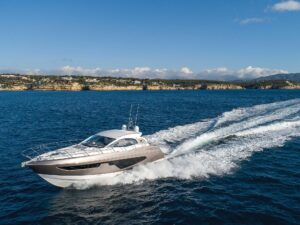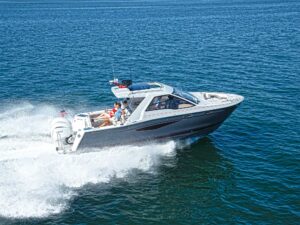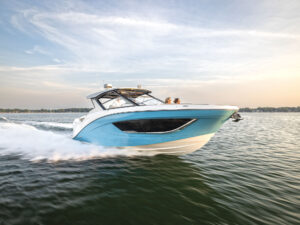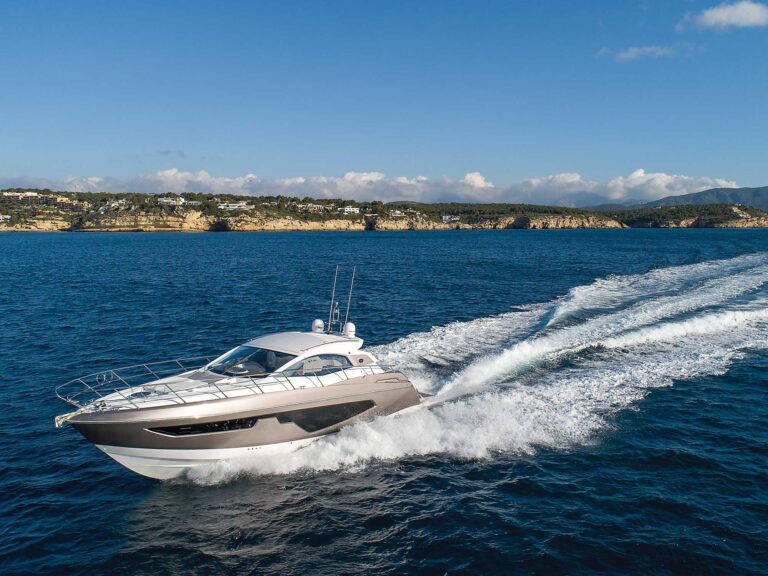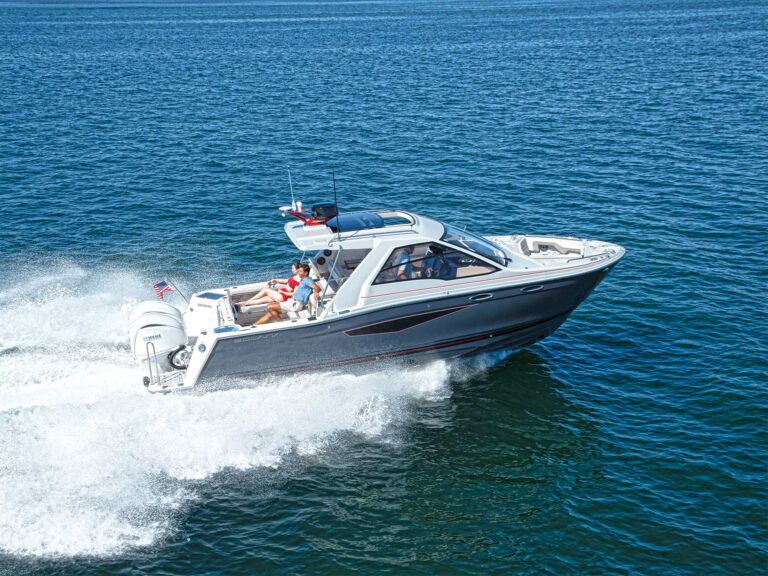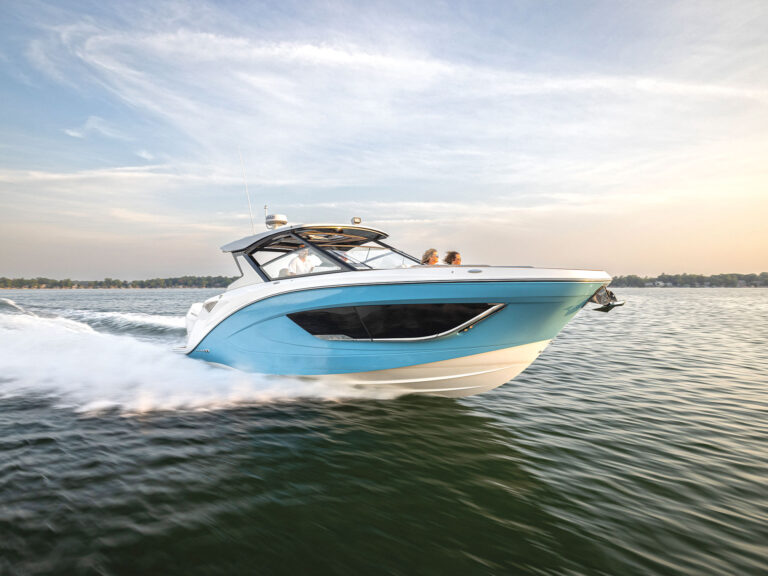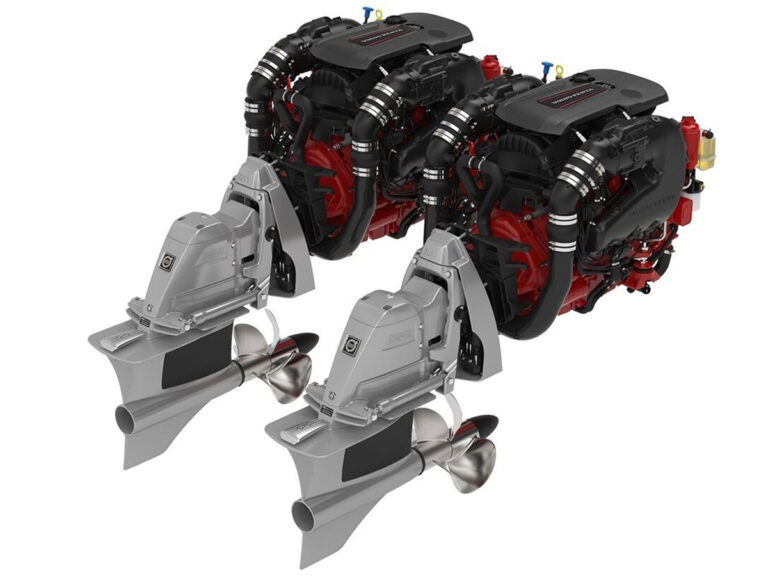You strive to balance work, family, and leisure time, so why shouldn’t your boat do the same? If you can have only one boat-and we’re betting that’s the case-it better do it all. Your wife and kids should enjoy it as much as you do. For them, it has to be totally comfortable, for you eminently fishable, and of course for everyone’s sake, it must be economically feasible. The best package we’ve found that accomplishes all this is the 26′ walkaround-style of fishboat.
It’s big enough for a good ride at sea, has a real cabin that offers weather protection, and there’s plenty of room to swing a rod (or three). It’s a great combo. The only problem is choosing the right one from a crowded field of contenders.
So how do you pick a winner? Don’t fret-that’s what we’re here for. We arranged to test a fleet of five from some of the best builders: the Boston Whaler 255 Conquest, Century 2600 WA, Cobia 270 WA, Grady-White Islander 270, and Pro-Line 26 Walk. We ran them all in the same place, at the same time, in the same three-foot choppy conditions-that means no hedging when we talk about performance and handling in rough seas. We looked at fishability and livability, then checked how each would affect your wallet. No ifs, ands, or buts-we found a winner. But all these boats were strong contenders for different reasons. Check them out. One of them might be your next boat.
Bop ‘N Chop
We try to have equal boats with equal power for these comparisons. But the Century and Cobia were delivered with twin engines that in some cases doubled the power of the contenders with single engines. Had they come with a single 250, we predict that they would have been right in line with the others, giving a top speed in the 38-to-45-mph range.
Charging into the snotty seas, the Boston Whaler’s ride was smooth. No ancillary gear vibrated, we stayed completely dry, and the hull met oncoming waves with a muted thud instead of the dreaded slam and bang. In calm water we hit a top end of 42 mph with only 225 hp, the fastest of any single-engine contender. We did, however, encounter a couple of difficulties getting to that speed. Our boat didn’t lift fully onto plane until over 3500 rpm, whereupon the bow dropped by three degrees and speed jumped by almost 10 mph. It would also fall off plane just as suddenly. Having little midrange planing speed could mean handling issues when you slow for rough seas.
With 400 hp on the transom, the Century ran a blistering 53.9 mph, which was only sixth-tenths of a mph slower than the lighter, higher-powered Cobia. You pay for this speed, however, by catching more air than water-our knuckles were white from gripping the pipework. Though the landings weren’t accompanied by any apparent damage, they were loud-bam! We had to slow to around 30 mph to find the Century’s comfort zone, where the ride became smoother and quieter.
With 450 hp, the lightweight Cobia carried the most juice. No surprise, then, that it was the fastest boat in this competition at 54.5 mph-a speed that takes you from sea level to low-level flight quite often. Although the landings weren’t as harsh as we expected, there was a lot of vertical motion. Yet the Cobia was so responsive and quick to execute commands that it gets points for a giggle factor. We couldn’t keep from firewalling the throttles and launching off a wave. Just try to stop yourself from grinning-we couldn’t. As with the Century, 30 mph seemed to be about the right cruising speed. But we caught a bit of spray, particularly when putting the beam to the seas.
The Grady-White, with its single 250, reached a respectable 39 mph with a level of comfort matched only by the Boston Whaler. The helm remained bone-dry throughout testing. We noted the tighter-than-usual fit of the Grady-White’s canvas, which is secured on tracks and wraps the windshield frame inside and out. Hit it with a hose and it’ll keep the water at bay.
Although the Pro-Line weighs less than the similarly powered Whaler, it reached only 40 mph. Its light weight doesn’t hinder its ride, which fell somewhere in the middle of the pack in terms of comfort. At full throttle, there was less noise and motion than on the Cobia and Century but more than on the Grady or Whaler. Note to anglers who go green while trolling: With its 19 degrees of deadrise and large, hard chines, the Pro-Line is exceptionally stable in a beam sea.
Nuts ‘N Bolts
All of our contestants have construction features that used to be found only on select boats: 316L-grade stainless-steel fittings; brass, chrome-over-bronze, or stainless-steel through-hulls; hydraulic steering; strong backing plates for deck hardware; heavy-duty vinyl cushions; bolted and backed stanchions and cleats; nonbinding, recessed hinges; and waterproof electrical connections. But the similarities end there.
The Boston Whaler’s construction is unique. It’s built with inner and outer hulls that are latched together before they’re cured. Foam is then pumped into the void between the hulls, forming a single, rigid structure. By virtue of this foam-rich construction, this boat has the most insulation around its fishboxes and is best at deadening sound. The fishbox hatches, however, slam noisily when dropped shut, and one creaked as we walked on it. A quiet hatch is a well-fitted hatch, one of many details that indicate careful building. The pump-share arrangement between the (optional) livewell and (optional) washdown didn’t provide enough water pressure.
The Century is built using more conventional methods, having a molded-fiberglass stringer system. The hull-to-deck joint is screwed, bolted, and secured with an adhesive/ sealant. Fishboxes are insulated with blown-in foam, as they are with the other boats, except the Whaler. Though quieter than those on the Boston Whaler, the Century’s hatches slammed too loud during our drop-shut test.
The Cobia has preformed foam stringers that are laid in place and then glassed in. This usually results in a light, strong structure. And at 4,080 pounds, this boat is no exception. The hull-to-deck joint is secured with an adhesive/sealant and chrome-plated stainless-steel screws dipped in epoxy. It’s the only boat here that doesn’t use bolts. The hatch on the fishbox slams loud enough to spook fish a mile away. In the cabin, the rope locker’s hatch isn’t hinged and therefore gets in the way when open.
Wood is still good-at least in the eyes of Grady-White. Like all Gradys, this boat has rot-resistant plywood stringers and frames that are encapsulated with fiberglass. The hull and deck are held together with bolts, screws, and an adhesive/sealant. The fishbox hatch has a gas-assist strut, so there’s no slamming. With a 1,100-gph pump, washdown pressure was the best of the bunch.
As with the Cobia, the Pro-Line uses lightweight preformed foam stringers and frames. The hull-to-deck joint is bolted, screwed, and sealed with an adhesive/sealant. Fishbox hatches are well fitted, and they fell shut with a satisfying clunk instead of a slam. Unfortunately, the anchor locker opens into the walkaround recess; one misstep while it’s open could rip it off its hinges.
Fish Fight
These boats are fast and well built. But if you can’t fish from them, what’s the point? With its transom seat folded away, the Boston Whaler has an unencumbered fishing space of 36.4 square feet. There’s a 5′ 9 1/2″ reach over the outboard from the cockpit. Although that’s a long way when fighting a lively fish, all our boats are only inches apart in this specification. The Whaler’s tackle locker has four small boxes. The raw-water washdown, coaming bolsters, and livewell are items Whaler deems optional ($1,804). We don’t. Two gunwale-mounted rodholders come standard. There are rodholders under the gunwales and in the cabin. At 8″ wide and 6″ deep, the sidedecks are navigable with a hot fish on the line. At its lowest point, the bowrail is 1’7″high-just above the American Boat and Yacht Council’s standard of 2′ from the deck to the top of the rail. The fishboxes are the biggest of our group, large enough for hundred-pound-plus tuna.
The Century’s 28 1/2 square feet of cockpit was the smallest of the group. We like that the 42-gallon livewell has a dedicated 800-gph pump and a gasket around the hatch. Twin tackle lockers are housed in the transom, where you’ll also find a cutting board and sink. More tackle can be stowed in two trays under the helm seat. Coaming bolsters and four gunwale-mounted rodholders come stock, and there are covered under-gunwale rodracks. The sidedecks are only 6 1/2 ” wide and 1″ deep, and you have to take two steps up to reach them. Getting to the bow with a fish on the line will be hairy, although the 2’1″ bowrail helps.
At 42.9 square feet the Cobia has the most spacious cockpit. The boat comes with coaming bolsters, two cutting boards, four gunwale-mounted rodholders, three under-gunwale rodracks per side, and knife and pliers holders. There’s also a pullout transom shower long enough to reach both cutting boards. And a 25-gallon livewell is centered in the transom with a dedicated 800-gph pump. The fishbox is too small to handle pelagic big game. Go forward and you see that this boat defies the normal description of a walkaround. There’s a single step up to a 7″-wide, 4 ½ “-deep sidedeck ringed by a 2′ bowrail. But the sidedecks end near the front of the cabin, where you need to step up onto the cabin top to continue going around the boat. This gains some headroom below but makes it tough to fish 360 degrees.
The Grady-White has 37.5 square feet of cockpit. Its 34-gallon livewell is located forward, under the passenger’s seat. It has a 1,100-gph dedicated pump and a full-column water inlet that distributes clean water throughout. This was the only boat with a livewell forward of the transom, and underway we noticed some overflow, which ran back into the cockpit. The livewell hatches on the other boats also leaked, but since they’re located on the transom, their overflow ran into the motorwell, so it wasn’t a problem. Grady says it has added a second latch to eliminate this problem. The sidedecks are 8″ wide and 8″ deep, backed by a rail 1’5″ high at the lowest point. Four tackle trays that stow under the side of the passenger’s seat base, six gunwale-mounted rodholders and three under-gunwale holders per side, a cockpit shower, and a cutting board all come standard. With the livewell forward, there’s room for a 20-quart cooler in the transom. But it’s too small to be useful.
We measured 32 square feet in the Pro-Line’s cockpit. It has a molded-in transom seat instead of one that folds away as on the Whaler and Grady. This molded-in seat takes up fishing room and creates a long reach around the prop. The Pro-Line has the smallest livewell at 18 gallons. There are two integrated tackleboxes, three under-gunwale rodholders per side, and four gunwale-mounted rodholders. Cockpit coaming bolsters come standard. The walkaround sidedecks are a strong point. They are 8″ wide, and being 8″ deep with 2′ high rails, offer the most secure passage forward. Plus, the walkaround widens toward the bow, making this the easiest boat from which to fish a full 360 degrees. However, the fishbox is sized for stripers, not tuna.
Fire Down Below
The Boston Whaler’s cabin is simple: a V-berth that converts into a dinette and a small counter with a sink. Four rodholders extend beyond the cabin bulkhead to accommodate big rigs, and a portable MSD hides under the aft end of the starboard berth.
You get a standard enclosed head with a portable MSD on the Century. The single-burner stove is standard, but the rest of the galley is a $786 option.
Cobia’s small galley includes an icebox, single-burner stove, and sink. Naturally, as on all the boats, the V-berth converts into a dinette. Though the standard portable MSD is open to the cabin, $736 will get you a true enclosed head.
The Grady-White could pass for a cruiser, having an enclosed head with a sink and shower. The galley has a refrigerator, single-burner stove, sink, and stowage cabinets. The stove is particularly notable, mounted on a sliding rack. The stove won’t light unless the burner is right-side up, yet it won’t slide back into the cabinet unless the burner is removed and stowed upside down, creating a new level of safety and stowage security.
The Pro-Line’s cabin has an enclosed head compartment with a portable MSD. There’s a standard galley with a sink, single-burner stove, and a refrigerator. Cabin decor is better than most, with such touches as curtains and cushioned bolsters lining the V-berth’s side pockets.
Payday
With a single two-stroke 250-hp motor, the Boston Whaler goes for $69,110. At this number, the boat is short on fishing features. A livewell, fishbox macerator, coaming bolsters, and raw-water washdown adds $2,468. Outfitting the cabin to meet the minimum level of the competition means paying another $940 for a portable MSD and a single-burner stove. That brings the boat to $72,518. Why the high baseline? Construction. Whaler’s building techniques take more time and cost more money.
We’re surprised at the Century’s $73,836 price when rigged with a single 250-hp Yamaha HPDI two-stroke outboard. This number includes all the fishing and cruising must-haves, except for the galley, which adds $786 for a total cost of $74,622. That makes this the second most expensive boat in the running.
The Cobia’s base price with a 225-hp four-stroke comes in at $62,386, the lowest starting point in this rally. To make a comparable list of features, add on $136 for a compass, $314 for a washdown pump, and $707 for trim tabs, for a total of $63,543-still a strong value.
The most expensive boat is the Grady-White, at $87,725 with a single 250-hp Yamaha HPDI. Why so much? There are a lot of standards, and most are a grade above the rest. Livewell and washdown pumps are dedicated and 1,100 gph instead of the more common 800 gph, or shared, pumps. The standard head is a fixed electric, not a portable. Plus you get items the others leave out, such as windshield wipers, a refrigerator, locking electronics box, vertically and horizontally adjustable seats, and windlass prewiring. Still, even with all these advantages, it’s a lot of money.
At $64,679 with a single 225-hp four-stroke on the transom, the Pro-Line is the most reasonably priced boat we tested. This figure gets you all the basic standards a fishing family demands, plus a fridge and that four-stroke. A bargain? You bet.
Last Call
Boston Whaler’s 255 Conquest holds several advantages over the competition: awesome construction, an extremely smooth ride, good single-engine performance, and a cockpit that screams “fish here.” However, the slamming, creaky hatches, and pump-share arrangement with the livewell and washdown are letdowns on an otherwise top-shelf fishing machine. Boston Whaler also fell short in the cabin, with no enclosed head, or galley. Add in the must-haves and watch the price climb.
Century’s 2600 WA strikes us as a fast, fun-to-run, all-around well-built and well-equipped boat. We also give it high grades in the looks department, with color-matching fabrics and gel coat graphics. However, with the smallest cockpit and a tight walkaround, this isn’t the best boat for fishing, especially since it’s so expensive.
Cobia’s 270 WA has speed, handling, strong but light construction, great pricing, and the largest cockpit. On the flip side, the galley icebox is a waste of space (does anyone still use them?), and it was downright painful to hear the fishbox hatch slam. Most important, the sidedecks end near the bow, creating a step-and a tripping point. In fact, it’s fair to ask whether this boat should even be called a walkaround.
Pro-Line’s 26 Walk is an incredible bargain. It has solid performance numbers, good ride, solid construction, sexy looks, and a great standards list. The cabin also comes better equipped than the norm, and the wide, deep walkaround was one of the easiest to navigate. But when it comes to fishing, the molded transom seat keeps you too far from the motors and eats cockpit space. Also, the livewell is tiny, and the cockpit is the second smallest of the group. Despite its strong overall showing, the Pro-Line just misses taking the day.
Grady-White’s Islander 270 is at the top, or close to it, in just about everything: ride, livewell design, overall fishability, walkaround safety, washdown potency, cabin and cockpit design and outfitting, and a long list of quality standard features. In fact, this boat tied or took first place in every category we considered except cost. Do its qualities outweigh the price tag? Yes. It’s no bargain, but at least you can see where your money has been spent. The complaints are few: Get rid of the useless transom mini cooler, and end livewell leakage. That said, this is our winning walkaround.

